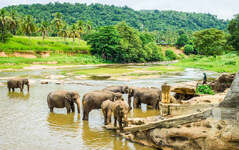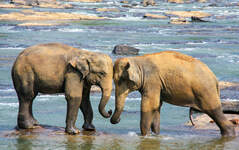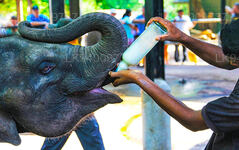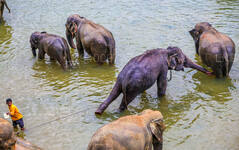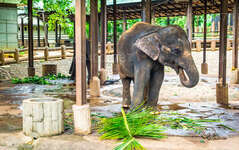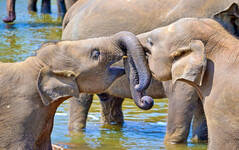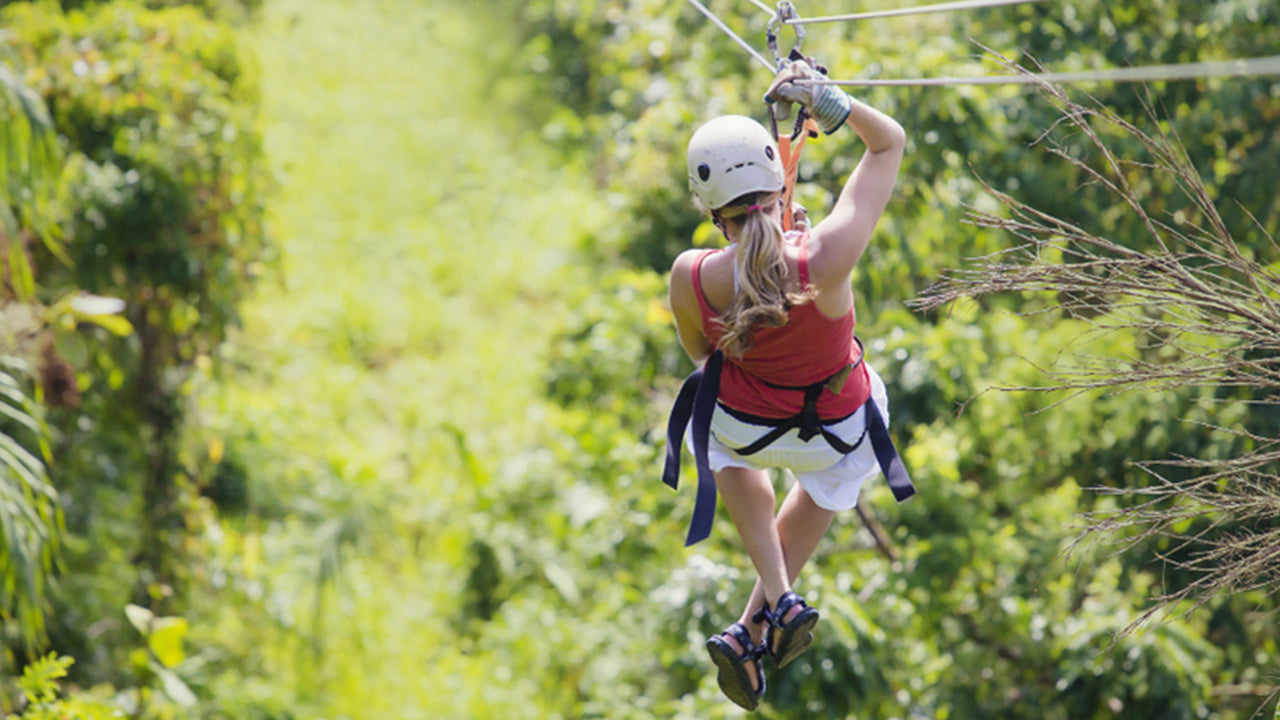
Pinnawala City
Pinnawala is a town in Sri Lanka known for the Pinnawala Elephant Orphanage. Established in 1975, it is a popular tourist attraction where visitors can observe and interact with rescued elephants. The orphanage plays a crucial role in elephant conservation and rehabilitation efforts.
Feeding Baby Elephants
An iconic constituent of the country’s wildlife, Elephants have over thousands of years been living in Sri Lanka where they have been revered for centuries. What’s more, it is Sri Lanka that cares for the world’s largest herd of orphaned Elephants.
So, if you have planned a trip to Sri Lanka, you will without a doubt take home fond memories of these gigantic yet gentle mammals.
Globally there are mainly two extant species of Elephants – the African elephant (Loxodonta) and the Asian elephant (Elephas maximus), but after recent extensive studies and DNA testing, the African elephant was further subdivided into two distinct species called African bush elephant (Loxodonta africana) and African forest elephant (Loxodonta cyclotis). The Asian elephant falls into three distinct subspecies: Elephas maximus maximus (living in Sri Lanka), Elephas maximus indicus (living in mainland Asia), and Elephas maximus sumatranus (living in the island of Sumatra). All these species of Elephants are of the Elephantidae family and The Proboscidea order.
Inhabiting tropical forests of the island, mainly lowland dry deciduous woodlands, scrubs etc. and frequenting nearby grasslands and cropped lands, the Sri Lankan Elephants, whose lifespan lies between 55 and 70 years, travel in cohesive herds that consist of about 8-12 individuals especially female adults and their offspring headed by the matriarch, but herd sizes can vary. Anyway, males who leave natal herds when they reach sexual maturity can be sighted wandering on their own or in temporary bachelor herds. Their cohesiveness is enforced by a complex communication system. A range of vocalizations, from low rumblings to high-pitched screams and trumpets, along with assorted visual signals is employed when they are close to each other.
Some of their rumbling, growling, bellowing, and moaning sounds of varied low frequency may travel long distances. These herbivorous proboscideans, that wander miles a day mostly in search of food and water, feed on a wide variety of vegetation including grasses, leaves, climbers, shoots, barks, roots, fruits, nuts and seeds and a large number of plant species have been identified to be fed on by Elephants in Sri Lanka.
Furthermore, Sri Lankan Elephants are highly intelligent, self-aware, social, emotional as well as strong. It is reported that they move to safer places when natural disasters occur. A classic example is that in 2004 when the tsunami hit the island, Elephants that were roaming in the coastal areas at the time had moved inland moments before the tsunami reached after sensing the looming calamity. These emotional beasts express their emotions using their trunk, ears, head, and tail. Also these species can easily be tamed and is capable of working under human instructions. In Sri Lanka, Elephants have been domesticated and used for various purposes over thousands of years. These powerful beasts have been used for transportation of people on their back, carrying, hauling and lifting logs and other heavy objects like stones used for construction purposes. In addition, these majestic proboscideans have been used for
religious and cultural as well as other ceremonial occasions and this human-elephant relationship dates back to a period of over 5,000 years.
It is also well known that ancient Sinhalese kings of Sri Lanka used captive Elephants even to wage war. Feeding Baby Elephants in Sri Lanka: Orphanages
The Pinnawala Elephant Orphanage was started in 1975 by the Department of Wildlife on a twenty five acre coconut property on the Maha Oya River at Rambukkana. The orphanage was primarily designed to afford care and protection to the many baby Elephants found in the jungle without their mothers. In most of these cases the mother had either died or been killed. In some instances the baby had fallen
into a pit and in others the mother had fallen in and died.
In 1978 the Pinnawala Elephant Orphanage was taken over by the National Zoological Gardens from the Department of Wildlife and a captive breeding program launched in 1982.
Feeding Baby Elephants in Sri Lanka:
Inside the Orphanage there are about 80 Elephants of all ages and sizes, walking around a fairly large territory.
For some extra rupees you can feed the Elephants fruits, like bananas and pineapples. The orphanage also houses baby Elephants, which are really cute! Apparently, it is possible for visitors to bottle-feed a baby elephant if you paid extra.
Visitors are completely enamored at feeding time when the younger babies are bottle fed with enormous amounts of infant formula, which they guzzle down in a few seconds. You can watch them feeding at 9.15 am, 1.15 and 5.00 pm.
The Elephants are controlled by their mahouts (keepers), who feed them and watch out so they don`t endanger anyone. They do however walk freely around the area and among the visitors most of the time.
About Kegalle District
Kegalle is a town in Sabaragamuwa Province of . It is located on the Colombo - Kandy road and 48 miles/78 km away from Colombo and 24 Miles/40 km away from Kandy. It is the Capital City of the Kegalle District which is one of the two districts belonging to Sabaragamuwa province the other being Ratnapura District.
District of Kegalle, situated in between the central highlands and western southern planes and has an enchanting environment. Height of the western region is less than 500 feet from the sea level while eastern region exceeds 1000 feet. Rubber cultivation has stretched over most of the area of the District and minor export crops such as coffee, cocoa,pepper,clove and nutmeg takes an important place in the economy of the District. Sri Lanka's best graphite mine is situated at Bogala in Kegalle District. The extent of the District is 1692.8 km2 (169,280 in hectares).
About Sabaragamuwa Province
The Sabaragamuwa Province of Sri Lanka contains two main cities called Ratnapura and Kegalle. At an elevation of approximately 500 feet above sea level, Ratnapura is the provincial capital of Sabargamuwa. It is 60 miles (100 km) from the main coastal city of Colombo. Province of Sabaragamuwa The gem-mining centre of Sri Lanka is also a major crossroad between southern plains and the hill country to the east.
In Sabaragamuwa province there is a route to Sri Pada from Ratnapura direction. Excursions include Sinharaja Forest Reserve and Udawalawe National Park. The route towards hill country is beautiful. The surrounding area is a popular trekking destination and a good place for bird watching.

